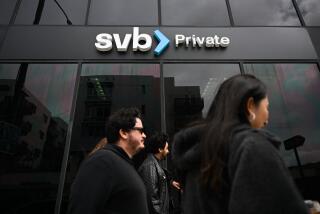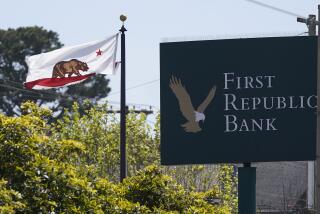How to Tell if a Thrift Is at Risk
- Share via
Which savings and loans are insolvent and may be taken over by the government? How can you tell if your S&L; is troubled? What should you do if it is seized?
Such questions are on the minds of many savers as they ponder the impact of the Bush Administration’s plan, announced this week, to assume control of as many as 350 insolvent thrifts in coming months.
Here are some tips on how to cope with S&L; bailouts:
Question: Which S&Ls; are insolvent and most likely to be taken over?
Answer: A joint task force of federal regulators plans to take control of 224 of the most troubled thrifts in the next few weeks. Takeovers of others may follow.
These S&Ls;, including about 15 in California, are likely to be put into conservatorships similar to that set up Tuesday at Pacific Savings Bank of Costa Mesa. Under such conservatorships, the institution remains open while the regulators tighten controls and evaluate further actions.
Eight in Southern California are seen as most likely candidates for government takeovers because they are insolvent. They are Westwood Savings & Loan of Los Angeles, First California Savings of Orange, Founders Savings & Loan of Los Angeles, Arrowhead Pacific Savings Bank of San Bernardino, Signal Savings & Loan of Signal Hill, Perpetual Savings of Santa Ana, Unified Savings of Northridge and Manhattan Beach Savings & Loan of Manhattan Beach.
Q: Can others join the list?
A: Definitely. Higher capital requirements proposed by President Bush could squeeze more thrifts into insolvency. Booz Allen & Hamilton, a consulting firm, said in a report released this week that some 1,000 other S&Ls--or; about one third of the nation’s total--are in poor financial shape and may not survive.
Q: How can I tell if my S&L; is insolvent or troubled?
A: There are several ways. One is to simply ask the institution for financial data. Banks are generally required by regulators to provide certain financial information to customers upon request. S&Ls; are not, but many will do so. Be suspicious of any institution that won’t give you such information.
You also can get S&L; financial information from the Federal Home Loan Bank Board, the chief regulator of thrifts, or one of its branches. For the most recent quarterly report on an thrift in California, Arizona or Nevada, send a $5 check to the Federal Home Loan Bank of San Francisco, Public Information Office, P.O. Box 7948, San Francisco, Calif. 94120.
Some independent newsletters and services provide lists and evaluations of the relative safety of banks and S&Ls.; For example, Jumbo Rate News & Rate Watch in Florida offers a list of 342 thrifts that were insolvent as of Sept. 30, 1988, according to Federal Home Loan Bank Board data. The list is available for $10 by writing “Short Timers” Thrift List, P.O. Drawer 145510, Coral Gables, Fla. 33114-5510.
Another service is offered by Veribanc. For $20, it will provide you a report on your institution, analyzing the data and classifying it from green (strongest) to yellow to red (weakest). It also has reports rating groups of institutions in a particular state, city or county. For a free brochure describing on their services, write Veribanc, P.O. Box 2963, Woburn, Mass. 01888, or call 617-245-8370.
Bear in mind, however, that data used in these and other reports are at least three months old--and a lot can change in that period. And the methodology used by Veribanc and others is not universally accepted.
Q: If I get financial data on my own, what should I look for?
A: One of the best measures is the ratio of so-called regulatory capital (generally equity capital, or net worth) to assets (primarily loans). Most analysts agree that 5% is a minimum for the strongest banks and S&Ls;, with 6% preferred for smaller institutions. But regulators currently require only 3% for thrifts.
Another good measure is return on assets, which measures profits as a percentage of assets. Analysts say 1% or more is a good sign.
But remember that these numbers are not foolproof, particularly if viewed in isolation. Gibraltar Savings in Los Angeles, for example, has a regulatory capital to assets ratio of more than 3%, but was recently declared unsafe and unsound by regulators.
Bank Rate Monitor, a Florida newsletter, offers a booklet “How Safe Is Your Money?” describing how to check the financial condition of an institution and providing other tips. It’s $2.50; write 100 Highest Yields, P.O. Box 088888, North Palm Beach, Fla. 33408.
Q: What should I do if my S&L; is insolvent, troubled or likely to be taken over?
A: If your deposits are fully insured under the $100,000 limit per depositor per institution, don’t panic. Your money is safe. The insurance will still apply in a takeover, and thus you will not lose any money. So it is not worth incurring any early withdrawal penalties if you have a certificate of deposit that is yet to mature.
In a conservatorship, at first it is business as usual. Government officials, acting as conservator, will evaluate the S&L;’s condition and identify further courses of action. And they will honor all loans and deposits.
The bulk of troubled thrifts taken over by the government are subsequently sold to investors or other institutions, or deposits are transferred. In those cases, your deposits are simply assumed by another institution, and you need do nothing.
If you have deposits over $100,000 that are not insured, however, transfer them to a financially strong institution. In a conservatorship, there still may be time to withdraw any uninsured deposits and place them in sounder institutions. But if you wait too long and the institution is closed, you could lose all or part of your uninsured money. That has happened in cases of several bank and S&L; closures.
Q: What if the government decides to close a thrift and give depositors their money back?
A: These are rare, since regulators prefer to sell a troubled thrift or at least transfer its deposits to another institution. With such a payout, you may be be subject to a wait of a few days getting your money. During that wait, you will not earn interest on your money.
If you can’t get to your institution, it may be as long as a week before you are notified of the closure and sent a form to claim your deposit.
More to Read
Inside the business of entertainment
The Wide Shot brings you news, analysis and insights on everything from streaming wars to production — and what it all means for the future.
You may occasionally receive promotional content from the Los Angeles Times.










